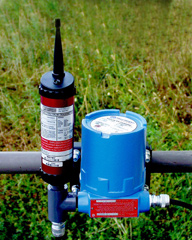|

 Probe shown in photo not included with corrosion transmitter
Probe shown in photo not included with corrosion transmitter
|
The MS2500E is an intrinsically safe, microprocessor-based corrosion transmitter capable of measuring and transmitting data from all types of electrical resistance (ER) corrosion probes.
Corrosion rate measurements are made using the electrical resistance method. Essentially, the instrument measures the resistance of the probe element which changes over time, as metal loss occurs. The rate of change is directly proportional to corrosion rate. This method finds a wide variety of applications since it can be used in conductive and nonconductive environments such as petroleum, chemical, water, soil, or even atmosphere.
Measurements are transmitted via 4-20mA current loop. Since current loop signals are not as sensitive to line loss as other types of data signals, the MS2500E may be located up to ten miles away from the data receiver under proper conditions.
|
The MS2500E is completely loop-powered, so installation is simple. A two-wire connection is all that is required for both instrument power and data transmission. Setup is also simple, using a set of switches to select the probe type to be measured (wire loop, tube loop, cylindrical, etc.).
The MS2500E is housed in a NEMA rated explosion-proof and weather-proof enclosure, and the probe cable is connected through a water-tight, explosion-proof cable gland. This makes the MS2500E suitable for use in almost any indoor or outdoor environment.
Technical Specifications
Model
MS2500E - Loop-Powered ER Transmitter (Ordering # IN2500)
| Physical Data |
|
| Instrument Weight: |
5.02 lb. (2.28 Kg) |
| Total Weight w/ Accessories: |
7.08 lb. (3.21 Kg) |
| Instrument Dimensions: |
5.81" H x 4.5" W x 4.81" D (14.76cm x 11.43cm x 12.22cm) |
| Case Specifications: |
Explosion Proof (FM, CSA, CENELEC, UL)
Class I, Groups B, C, D, Class II, Groups E, F, G, Class III,
CENELEC: Eexd IIC
NEMA 4, 7BCD, 9EFG |
| Mounting Specifications: |
0.728" H x 1.756" W (1.85cm x 4.46cm) Bolt Pattern with 1/4-20 Tapped Mounting Holes, or may be mounted on a 1/2" to 2" (1.27cm to 5.08cm) pipe using supplied hardware |
| Operating Temperature: |
0° to 140°F (-18° to 60°C) |
| Storage Temperature: |
-40° to 176°F (-40° to 80°C) |
| Performance Data |
|
| Measurement Type: |
ER measurement using any standard ER probe type (wire loop, tube loop, cylindrical, flush, strip, etc.) |
| Range: |
0-100% of probe life |
| Resolution: |
0.4% of Full Scale |
| Cycle Time: |
1 Minute |
| Electrical Data |
|
| Power Requirements: |
10 to 35 VDC |
| Maximum Probe Cable Distance: |
5 ft. (1.52 m) |
| Output Specifications: |
4-20 mA Current Loop Output |
| Intrinsic Safety: |
Certified to CAN/CSA
STD E79-0-95 & E79-11-95
Class I, Division 1,
Groups C and D, T4 |
| Special Features |
|
- Switch selectable probe type (wire loop, tube loop, cylindrical, etc.)
- Loop powered
|
MS2500 Wireless Radio Option
| Accessory Items |
|
|
5' Probe Cable (attached), Meter Prover, Mounting Hardware, Operation Manual
|
 |
The integrated wireless radio and I/O module eliminates cable and conduit used by the standard 4-20 mA current loop version of the MS2500E/MS2500L, making it better equipped for harsh industrial environments. The wireless radio utilizes 900-928 MHz ISM band spread spectrum, frequency-hopping technology to guarantee a license free, interference free link between remote devices and the control room.
Costly cable and conduit runs on new projects, or retrofitting of existing systems, are eliminated and replaced with a maintenance free, reliable and versatile wireless solution.
The set consists of an outdoor transmitter, receiver, and two antennas.
|
Features of the Wireless Radio
• Interference free, frequency-hopping, spread spectrum technology
• License free 900-928 MHz band
• Easy to use, wire in/wire out, no setup or programming
• 180-300 m (600 to 1000 ft.) range in plant without line of sight with included antennas
• Range with optional omni-directional antenna --- receiver and transmitter = 6-8 km (4-5 mi.)
Electrical Data
Power Requirements: 12 to 35 VDC
Intrinsic Safety: Class I, Division 2 approved for hazardous area

|

|
